


March 7, 2010
Volume II, Issue 4
www.303rdBG.com
by Kathy Stanclift
kmstan@dslextreme.com
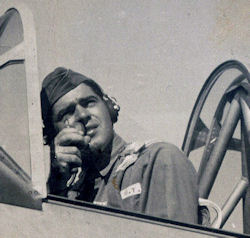 |
While gathering my thoughts and information for this, I have come to the realization that I have a whole new "take" on the story; a profound appreciation for the 303rd BG website, and the ways it has changed my life.
Growing up, I knew that my dad had been shot down and captured spending several years as a POW in Stalag Luft III among others. When asked about it, he never said much other than to tell my siblings and me that as an officer, he "had it better than a lot of the other guys." End of story. Dad wasn't big on details.
In 2000 (or so), my cousin decided to find out a bit more about my dad's history and spent a couple of years piecing together his war data on the internet. That's when she came across the 303rd BG website, and had me check it out. I spent hours on-line, and even posted a little "thank you" to Gary and anyone else who was instrumental in keeping it up to date. I had no idea how much this one posting would impact our lives in the future.
On January 19, 2004, I arrived at work and opened my e-mail. Just another day after a long weekend, and yet there was an e-mail from a stranger regarding Lt. Oran T. O'CONNOR. Of course, when you don't know the sender, you should not open any such e-mail, but I couldn't resist!
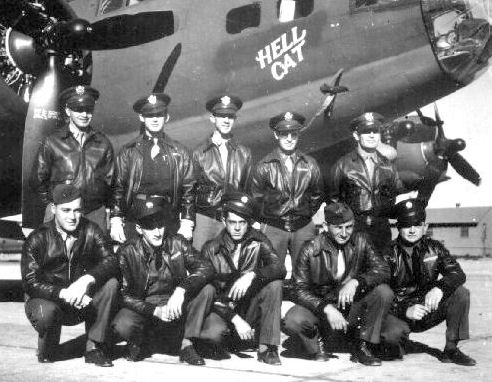 |
I could hardly contain myself! I called my husband, who is a Vietnam Vet, and asked what he thought of this e-mail, as I was so surprised and shaken, I didn't know what to think! His first thought was that maybe this man was fathered by an American Aviator, and was looking for his father. Hmmm. That didn't really sit too well. John also explained that in the context of the e-mail a "souvenir" was not what I thought it was; it was more like a memory.
At lunch I called my dad. His reaction was that it was probably the guy whose stone wall he'd plowed the plane into, and he was trying to collect for damages! Great. Always the joker. Wouldn't anyone take this seriously? I figured I was on my own. I began to correspond with Jean Paul. My first question was how he'd gotten my e-mail address? Easy, he responded. After three or four days, I found your posting on the 303rd website! Very interesting. And then I started to find out more about Jean Paul and why he cared so much.
Jean Paul was a young boy during WWII, and had witnessed a P-38 plane crash in his village. His mother took him and his brother to view the badly burned body of the pilot so that they would understand what the Americans were sacrificing so that perhaps the boys would someday live in a free country. It was a lesson Jean Paul never forgot. He told me that from that moment, he pledged that when he grew up, he would commit his life to "paying homage to the American Aviators who gave so much".
Jean Paul Favrais is a man of his word. Once retired, he spent the next four years of his life, researching the name and family history of the pilot of the P-38 who had crashed in his village when he was a boy. Once Jean Paul found the pilot's name (Russell Quinn), he then set about the tedious task of locating any living relatives. He was determined to erect a monument in his village of Breal, France, to memorialize this man, and wanted his family to know that he had never been forgotten by the people of that town.
After four grueling years of research, Russell Quinn's sister and nephew were located, and they came to Breal for the dedication ceremony of the memorial that Jean Paul and Henriette had built with their own money. What dedication!
After that experience, Jean Paul had to keep going. To that end, he was investigating every mission flown by the 303rd BG, and was working on the mission during which my dad's plane was shot down. It happened to be a mission in which the 303rd had a particularly high injury and casualty rate. The mission was to bomb submarine pens in Lorient, France. Ninety aircraft were sent out that morning. Thirty-one aborted the mission, and five were shot down or lost at sea.
Once Jean Paul's e-mail's began along with his questions about the plane, the crew, etc., so too did Dad's stories and memories. Dad's recall (at age 90) of the incident was pretty remarkable in detail. He knew the layout of the area, and what the plane looked like when it came to rest. He even knew the exact positioning of the wing that was torn off when the plane came to rest in the field.
He'd always told us "kids" (I have 9 siblings) that he'd been shot down, but we never had a lot of details. I found that after dropping the bombs on the target in Lorient, they were immediately engaged in a dogfight. The bombardier was shot in the chest, and the radioman helped him bail out. The #2 engine was on fire and had to be feathered, and the # 3 and 4 engines were on fire. There was a huge hole in the fuselage, and the tail gunner, Frank Batterson, had been injured very badly, and couldn't get out of the plane. Dad decided that he had to go down with the plane and do his best to get it on the ground if he could without killing both of them. He tried to make it look as if the plane were out of control, but the Germans knew there were still two crewmen in the plane and followed them down most of the way.
Dad had said that he thought he'd lost consciousness for a short time after the crash, but wasn't certain. He knew that he was cut badly on the face (all the way through his upper lip), was bleeding badly, and had broken ribs. The next thing he talked about was being taken to the hospital in a truck by a young German guard. He said the hospital was run by French nuns who were fearless when it came to the Germans. He also said there was so much blood on the floor of the operating room when he got in there, that he thought that Batterson must be dead. Batterson had survived, but had to have his leg amputated; thus the blood. I could not believe how clear his memories were now that he was talking about the past. It was extraordinary. I had never felt as close to him or as much a part of his life as I did during those last years.
During this time, too, I came to know and love Jean Paul and his wife Henriette as if they were part of our family. In August 2006, Dad died peacefully just a few weeks short of his 92nd birthday. Jean Paul and Henriette grieved deeply with our family during our time of loss.
Shortly after we had laid our dad to rest at the Veteran's Cemetery in Phoenix, AZ, my oldest sister Mary, gave me the news that Dad had left a gift of a small inheritance. Enough for my family and I to travel to France, perhaps see the area where he had been during the war, and meet Jean Paul and Henriette. We were all thrilled beyond belief. My husband John started brushing up on his French (as Jean Paul speaks very little English) and we planned our trip for the Spring of 2007.
 |
The morning after our arrival in Brittany, April 6, 2007, was a day I will never forget. Jean Paul and his wife Henriette picked my husband John, our son Kyle and me up at our hotel in the morning, and drove us to Carhaix-Plougher, where we were met by several other people. One of whom was Monsieur Blanchard, who does the research with Jean Paul. Monsieur Blanchard and his father had been members of the French Resistance, and had assisted many Americans during the war. They had arranged for the Director of the Hospital to meet us to show us the documentation and the old part of the hospital where dad had been. The sights brought tears to my eyes.
From there, we drove on to Poullaouen, a small village where they had finally located the crash site! We were met there by the Mayor, his parents, a newspaper writer, and photographer. I felt like a I was famous! After introductions were made, the caravan left and we drove to the farm. There, we met Michel, whose father had owned the farm, and Madam Blaise, Michel's cousin.

At the house where O'Connor was hidden are Monsieur Blanchard, Kathy Stanclift,
the Mayor of Poullaouen, the Mayor's mother and Jean Paul Favrais.
The town Mayor served as translator for me, as I don't speak French, and explained to me while Madam Blaise told the story of the crash. She was 7 years old and in the upstairs of the farmhouse the day the B-17 crashed, she told me. "Your father was a very brave and gifted pilot. When I saw that plane coming, I thought that it would certainly hit the house, but then the wing tipped up just enough to miss the roof, and came to land in the field on the other side of the house.", she said. The tears were forming in my eyes, as she reached into her pocket and took out an envelope. She told me that she and her mother ran to the plane along with her uncle to see if there were survivors. She was so afraid. Her uncle dragged Batterson from the back of the plane. He was bleeding so badly, that they took him to the farm. They could see the Germans coming already, and knew he needed medical attention immediately. Her uncle then helped dad out of the plane and told him to run across the field where others would try and hide him.
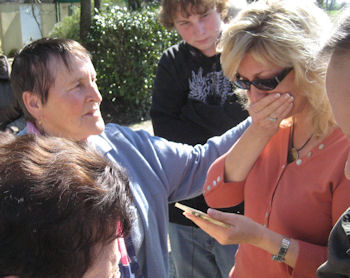 |
Our last stop of the morning was to meet a woman named Genvieve. She and her family had lived across the valley from Madame Blaise, and it was to her home that Dad had run. Her father had him hide in the small family home, but it was not long before the Germans were there. "No Americans," they tried to tell the soldiers. Both Genvieve's father and mine were taken prisoner that day. Her father was sent to a work camp in Rennes, and Dad was off to Stalag Luft III after healing from his wounds.
What a remarkable journey it has been, and I felt that my Dad was with me every step of the way. Along the way, I also found that though some of the members of the 303rd are gone, they will never be forgotten. And for that, Gary and Jean Paul, I can never thank you enough!
![]()
Target: Power Station and Bridge, Lorient, France
Crews Lost: 1Lt Martin E. Plocher
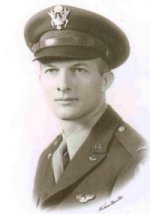 |
 |
2Lt Clair A. Tyler (CP) and Sgt Robert L. Stevenson (LWG) were hit and killed instantly. A fire started in the radio room that was extinguished by T/Sgt Everett E. Friese (R). An explosive 20mm entered the B-17's nose, hit the armor plate, exploded . Shell fragments penetrated the backpacked parachute and wounded 2Lt Ellera J. Corwin (N). S/Sgt August E. Tornow (TG) was also wounded. Two enemy fighters attacked the aircraft. One was shot down and the other flew away. 1Lt Plocher then put his B-17 into a dive and leveled off at 500 feet above the water. All non-essential loose equipment, guns, etc. were thrown out to lighten the load. With three engines shut down, 1Lt Plocher decided that the best thing to do was to maintain the flight heading back to England and try to hold his altitude. The B-17 was flown for about 40 minutes when the #4 engine started to belch black smoke, indicating that it was over-heated and losing power. The crew was commanded to take their ditching positions and brace for impact. The B-17 was maneuvered to a large swell and settled down on the water. It was a good landing, one that you never get to practice. 1Lt Plocher crawled out through his left cockpit window and down on the wing. His life raft gave a hissing sound letting him know it had been punctured by bullet holes. He reached into his pocket for handkerchiefs and found enough to plug the holes. He then hooked up the pump and inflated the raft. He immediately moved the raft off the wing and got in. The plane stayed afloat for about two minutes, then sank with the bodies of Lt Tyler and Sgt Stevens.
Lt Plocher reached a life raft where Lt's Ellera J. Corwin and William F. Kahlden, with their life jackets on, were bobbing in the water. Lt Plocher boarded the life raft and pulled the other two aboard. They then spotted the other life raft with five crewmen aboard and managed to tie the two rafts together. As the sun began to set, the crew heard an aircraft. A German fighter spotted them and flashed its landing lights before veering away. Around midnight, all of the crew shivering from the cold and wet after floating for 12 hours, saw a light sweeping the water some distance away. A loud and clear English speaking voice asked who we were. Again the voice spoke and was recognized as having a German accent. The German vessel approached the rafts and lowered a 30-foot ladder. Lt Plocher was the last crewman to make the climb.
1Lt Plocher, 2Lt Corwin (N), 2Lt Kahlden (B), T/Sgt Henry R. Legge (E), S/Sgt Edwin L. Matheson (TT), T/Sgt Everett E. Friese (R) and S/Sgt Louis W. Rheaume (BT) spent the next 26 months as POWs. Wounded Tail Gunner, S/Sgt Tornow, was repatriated by the Germans.
See: Plocher Crew and Mission #20.
First Large-Scale Daylight Attack on Berlin, Germany
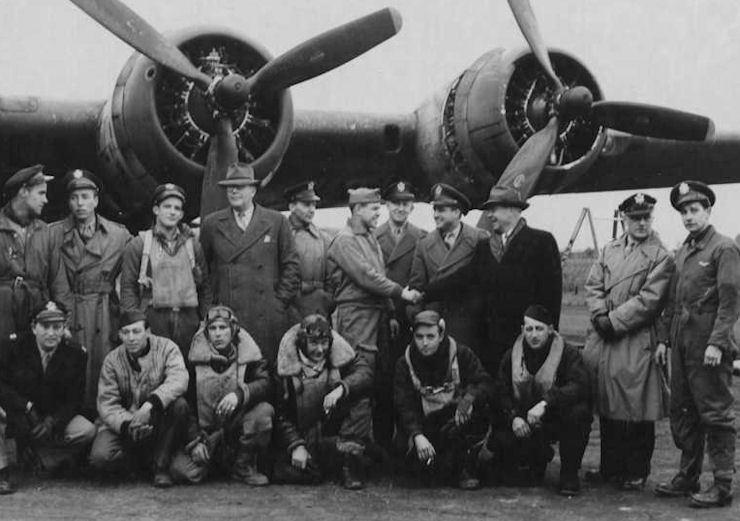
Lead Crew and dignitaries following the March 6, 1944 mission to Berlin. The Lead Crew consisted of: Maj Richard H. Cole (P),
1Lt Thomas J. Quinn (CP), 1Lt Gerald M. Palmer (N), 1Lt Richard R. Bowen (B), 1Lt Robert H. Halpin (TG-O), T/Sgt John C. Mayhugh (E),
T/Sgt Lloyd C. Mouser (R), S/Sgt Patrick N. McCauley (BT), S/Sgt Joseph E. Robichaud (RWG) and T/Sgt Kurt J. Hermann (LWG).
Berlin was the target and the entire 1st Bomb Division bombed in the first large-scale daylight attack against the German capital. Twenty-seven 303rd BG(H) aircraft were dispatched. 1Lt. John C. Lawlor, flying in the No. 7 position of the 360BS 379/384BG Composite Group in #42-31055 Aloha, lost his No. 4 engine 15 minutes before reaching the target and jettisoned his bombs near Werferlinger, Germany. The other 26 B-17s dropped 50 tons of 500-lb. G.P. M43 bombs in a suburban area about six miles east of the heart of Berlin. The M47A1 65-lb. incendiary bombs of the High Group, in which the 360BS was Low Squadron, covered six blocks of a residential area. Bombing was done from 19,800 and 22,000 feet by PFF. The 8th Air Force dropped more than one million leaflets over Berlin.
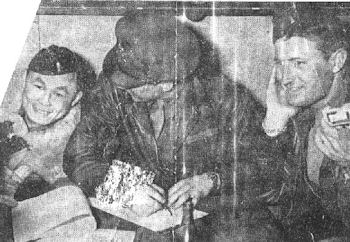 |
The first 8th Air Force mission to Berlin was on 4 March 1944, but it was not executed as planned. The 3rd Bomb Division dispatched 238 B-17s, but the weather deteriorated to such an extent that only 30 Fortresses dropped their bombs on Berlin. General Doolittle tried to get permission to lead this mission flying a P-51, so he could claim the honor of being the only person to have led raids on Tokyo, Rome and Berlin–the three Axis capitals. General Tooey Spaatz gave him permission to fly on the 4 March mission, but changed his mind at the last minute. He stated that he couldn't afford to risk the capture of a senior officer with knowledge of the invasion plans.
The Berlin mission on 6 March 1944 was much more successful, but the loss of 53
B-17s, 16 B-24s and 11 fighters dimmed the success. The heavy losses were a new record
for an 8th Air Force mission. Three of the B-17s landed in Sweden. Fighter pilots made
claim to 82 enemy aircraft destroyed, 9 possibly destroyed and 32 damaged.
![]()

Crew members checking the machine gun camera which will be installed in this B-17 - March 13, 1945
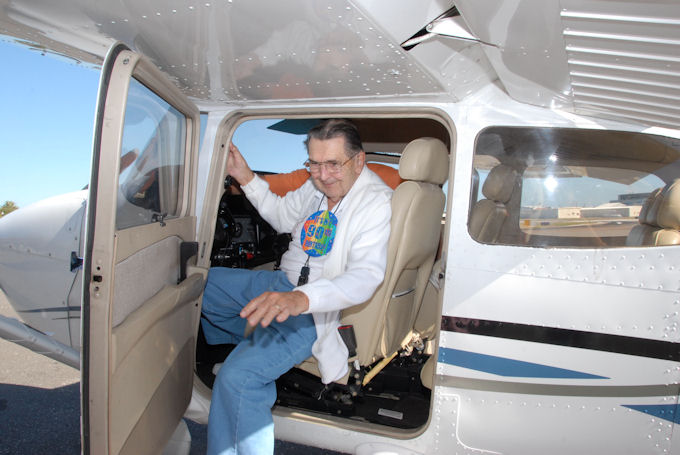
Over sixty-six years after Bill Eisenhart flew his first combat mission in the fall of 1943, he had the opportunity to fly again. The occasion was his 90th birthday, January 25, 2010, and the plane was a Cessna 172 rather than a B-17.
Bill Eisenhart flew a total of 84 missions in his nearly 35 year career as an Air Force pilot, including WWII and Vietnam. His last mission in WWII was on April 17, 1945. His last mission was flown in Vietnam on April 2, 1973. He retired in 1977 with his wife Mary, to St. Petersburg, Florida. But, he continued to fly, never wanting to give up his high-flying days. He and Mary owned a Piper 180 with several local business friends, and the two of them took off for places of fun and visiting family and friends as often as they could. In 1984 they sold their share in the plane and Bill settled to staying on the ground. Life moved on and a new sport took over – golf.
Mary passed away in 2006 after over 61 years of marriage, leaving Bill alone and unsure of his future. In 2007 he remarried a woman that had been in the periphery of their family gatherings for years. One day last summer, Bill said longingly to his new bride Penny, "Gee, I'd love to fly an airplane one more time." He said this just as a small boy would longingly look forward to having his first choo-choo train. Penny had an idea. It took over seven months to put it all together, but on Bill's 90th birthday, he got to fly a plane again, in the left seat, with nearly 60 people cheering him on!
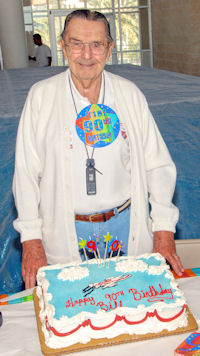 Bill said, "I never expected to complete a 90th FUN MISSION on my birthday at the party Penny put together. I was so happy to see so many of my friends and was really enjoying having some of my family here for the occasion, when in the midst of the chatter, I was paged to fly a mission. Lo and behold, there was my old flight instructor, Ron Methot, in a plush Cessna 172."
Bill said, "I never expected to complete a 90th FUN MISSION on my birthday at the party Penny put together. I was so happy to see so many of my friends and was really enjoying having some of my family here for the occasion, when in the midst of the chatter, I was paged to fly a mission. Lo and behold, there was my old flight instructor, Ron Methot, in a plush Cessna 172."
"I was a little flustered by being swept along, right into the left seat. I was glad I could still make the step!" Bill laughs.
"There was one tiny glitch. As everyone was watching from a second floor deck, waving and cheering me on, the airplane would not start! Well, let me tell you, there were plenty of cat-calls from my cronies, like 'Hey Bill, just like war days!' and the Army and Marine guys really had some things to shout, which I won't repeat here. Well, the APU tractor arrived and got us started. I took off my cap, put on my headset and mouthpiece and we began to taxi out to the runway! I was almost too busy looking at the new computer control panel to notice all the people still cheering me on. I did see my two little granddaughters, Shannon (12) and Isabella (3) down the tarmac, shouting, 'Fly, grandpa, fly!' And fly I did! It was a windy day, but the plane handled beautifully. I just couldn't resist the temptation. I did a 100 foot fly-by right down in front of the crowd – they were sure surprised – then just to show off a little, I tipped my wings to them and took off." Bill gets a big smile on his face recalling that moment.
Bill flew for about 15 minutes. When he landed and was taxiing up to the airport, all the guests came out on the veranda and down to the tarmac with horns, welcoming him back. When he got out of the plane, his son John helped him take the step out, and for a moment father and son were united. John said, with the faintest hint of tears, "Dad that was great! I'm proud of you!" As Bill walked across the tarmac, he paused to take it all in – the roaring crowds, the horns blowing and the beautiful smiles on all those special people who made time on a Monday afternoon to come help him celebrate his 90th birthday. And Bill says, "It was a great way to cap a period of 90 years on the planet!"
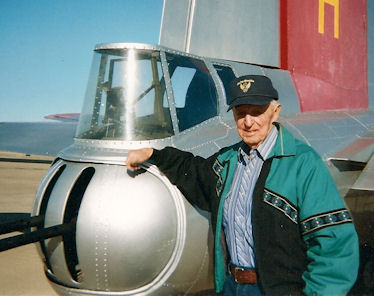 |
An unexpected opportunity to fly again in a B-17 was given to Beryl Kindred, tail gunner on the 358th BS 1Lt Lawrence E. Poole Crew. On November 3, 2009, the Experimental Aircraft Association's B-17G "Aluminum Overcast" made a tour stop in Enid, Oklahoma. Enid's EAA Chapter President, Ray Gill and Beryl had visited on several occasions about Beryl's service as a B-17 tail gunner in WWII. Ray wanted to honor Beryl for his service, and did so by presenting him with a ticket to fly on "Aluminum Overcast." During the pre-flight briefing, the pilot learned of Beryl's WWII service and asked if he would like to occupy the navigator's seat during the flight. Beryl gladly accepted. The flight was exciting, Beryl said, and he enjoyed it very much, "especially since the visibility was unlimited and there was no flak or enemy planes to dodge." The B-17 "Aluminum Overcast" tours the country each year offering rides and tours. Information is available on their website.
 Joseph B. Strange, 87, died Thursday February 25, 2010 at Owen Valley Health Care Campus in Spencer, Indiana.
Born March 30, 1922 in Washington, he was the son of John E. and Anna C. (Williams) Strange.
A 1941 graduate of Washington High School, he enlisted in the Army Air Corps in 1942 where he served during World War II and Korea, retiring from the Air Force in 1964. [M/Sgt Strange was a Crew Chief in the 359th Bomb Squadron and was awarded the Bronze Star for his excellent service.]
Joseph B. Strange, 87, died Thursday February 25, 2010 at Owen Valley Health Care Campus in Spencer, Indiana.
Born March 30, 1922 in Washington, he was the son of John E. and Anna C. (Williams) Strange.
A 1941 graduate of Washington High School, he enlisted in the Army Air Corps in 1942 where he served during World War II and Korea, retiring from the Air Force in 1964. [M/Sgt Strange was a Crew Chief in the 359th Bomb Squadron and was awarded the Bronze Star for his excellent service.]
He moved his family to Bloomfield and worked at NSWC Crane until retiring in 1986. He was a member of Holy Name Catholic Church and a lifetime member of the V.F.W. in Middletown, Ky.
Survivors include his wife of 63 years, Lucille (Booker) Strange of Bloomfield; daughter, Susan (Neil) Yake of Bloomfield; sons, John (Brenda) Strange of Louisville, Ky., Tom (Joyce) Strange of Cory, and Doug (Kim) Strange of El Dorado, Calif.; grandchildren Kriste Strange, Holly Sanford, Erik Strange, Jessica Holtsclaw, Justin Yake, Ryan Strange, Chad Strange and C.J. Strange; and eight great grandchildren.
He was preceded in death by his parents; one brother, George Strange; his son, David Strange; and his great-grandson Abe Holtsclaw.
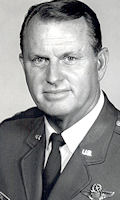 Colonel (Ret.) Howard F. O'Neal, a highly decorated Air Force Officer and former Base Commander at Mather Air Force Base, has passed on at the age of 84 in Sacramento on February 27, 2010. He was born in Knoxville, Tennessee, on May 18, 1925.
Colonel (Ret.) Howard F. O'Neal, a highly decorated Air Force Officer and former Base Commander at Mather Air Force Base, has passed on at the age of 84 in Sacramento on February 27, 2010. He was born in Knoxville, Tennessee, on May 18, 1925.
After graduating from Knoxville High School in 1944, he enlisted in the US Army Air Corps and was assigned to the 303rd Bomb Group, 8th Air Force, based in England. At the age of 19, he served as a B-17 tail gunner and flew 35 combat missions in Europe. Following his discharge from the service in 1945, he attended the University of Tennessee and played on the football team and also served in the Naval Reserves and as a firefighter in the Pacific Northwest. In 1948 he entered the US Air Force as an aviation cadet and was commissioned as a second lieutenant.
During his years of service, Howard served our country in many capacities including being an instructor for the Air Force ROTC at Penn State; Deputy Chief for Plans and Operations and Chief of the Inter-service Group at the Pentagon; Base Commander of Mather AFB in Sacramento, Utapao AFB in Thailand, Hickam AFB, Wheeler AFB, Bellows Air Force Station (all in Hawaii), and Wake Island AFB.
Colonel O'Neal retired from the Air Force in 1978. His awards and decorations include the Legion of Merit, Distinguished Flying Cross, Bronze Star, Meritorious Service Medal, Air Medal with eight Oak Leaf Clusters, Air Force Commendation Medal with three Oak Leaf Clusters, and campaign medals from World War II and Vietnam. He twice refused the Purple Heart, feeling his injuries weren't severe enough to warrant it.
The O'Neal family returned to Sacramento and Howard worked for 10 years as Chief of the Combined Federal Campaign for the United Way. He was also active in the Rancho Cordova Rotary Club, the Rancho Cordova Chamber of Commerce, and the Order of Daedalians, a military pilot's group.
Flying was his greatest joy, and he took pride in being one of the best air-refuelers in the Air Force. Howard loved to travel and he and his wife Mary Lee vacationed in Europe on several occasions. He also loved opera, and if he was wearing headphones there was probably some Puccini playing. His carpentry skills produced many home projects, and his green thumb was evidenced in the abundance of backyard tomatoes. He was always up for a game of handball, but being outside on the golf greens was his preference. His love of football remained paramount all his years, and cheered enthusiastically for the Washington Redskins. He also enjoyed the company of his cats and was an advocate for the Sacramento SPCA. His sense of humor was legendary; he had an extensive repertoire of jokes and never missed an opportunity to tell one.
He is survived by his wife of 58 years, Mary Lee Strickland O'Neal, eldest son Casey O'Neal and daughter-in-law Colleen Shanley, daughter Kitty O'Neal and son-in-law Kurt Spataro, and younger son Chris O'Neal. Surviving grandchildren include Rachel Warren, Sarah O'Neal, and Evan O'Neal, as well as great-grandchildren Molly and Rose.
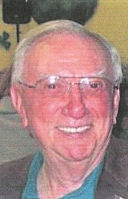 Major George Turinsky (retired) died February 19, 2010 in Auburn Calif. George was born March 15, 1924 in Edwardsville, PA to Basil and Veronica Turinsky.
Major George Turinsky (retired) died February 19, 2010 in Auburn Calif. George was born March 15, 1924 in Edwardsville, PA to Basil and Veronica Turinsky.
George graduated from Luzerne High School in 1942, and with his brother John enlisted in the USAAC. George graduated from pilot training and was assigned to the 303rd Bomb Group 8th AF. As a B-17 pilot he flew thirty five missions against Nazi Germany. After the war he served in Alaska with the 72nd Recon Squadron. He married his first wife, Ann Kobelka of Canada for thirty six years until her death in 1991. George's military career took them to Texas, Germany, Italy and finally to McClellan AFB, where he retired after 21 years of service. While stationed in Germany, George and Ann adopted their two children Gregory and Diedre.
In 1993 he met his second wife, Anne M. Hagan and fell in love again. They were married May 15, 1993 and together they made their final years golden. They RV'd through the Western US and Canada accompanied by their dog Emma, who was their baby. George and Anne enjoyed the friendships of their many friends at social outings, including Taco and Spaghetti Nights at the Elk and church followed by breakfast with close friends on Sundays. He always looked forward to his Friday poker sessions with his SIRS buddies.
In addition to leaving his wife Anne, he also leaves son Greg and wife Linda of North Highlands, daughter Diedre of Placerville and his grandchildren JuLee, (Jack) Simpson, Steven (Melissa) Turinsky, James Gray and Michael Yaksitch, great grandchildren Landon and RosLynn. He also leaves Anne's five children, their children and grandchildren along with many cousins nieces and nephews. George was a member of BPOE #1691, a life member of the VFW, AF Sergeants Association, Patron member of the NRA, the 8th AF Historical Society and the 303rd Bomb Group Association.
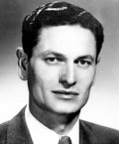 Charles Garland Allard, 89, died peacefully on February 24, 2010 surrounded by the family he loved so much. Born on February 10, 1921 in Ireland, Texas, Garland spent the last 26 years of his life in Austin. He was the next to youngest of the seven children of Charles Dow Allard and Maggie Cherry Allard. He spent his childhood in Dawson, Texas where he developed an ardent love of learning. Growing up in a large family in a small Texas town during the 1920s and 30s, Garland understood early on the values of duty, honesty, integrity, economy, and love of family, as well as the virtues of hard work and self-reliance. He exemplified these values and virtues throughout his long and wonderful life. After attending public schools in Dawson, Garland studied at TCU and Baylor and ultimately received a Bachelors of Education from North Texas State Teachers College. He then began his career as a teacher and vocational counselor.
Charles Garland Allard, 89, died peacefully on February 24, 2010 surrounded by the family he loved so much. Born on February 10, 1921 in Ireland, Texas, Garland spent the last 26 years of his life in Austin. He was the next to youngest of the seven children of Charles Dow Allard and Maggie Cherry Allard. He spent his childhood in Dawson, Texas where he developed an ardent love of learning. Growing up in a large family in a small Texas town during the 1920s and 30s, Garland understood early on the values of duty, honesty, integrity, economy, and love of family, as well as the virtues of hard work and self-reliance. He exemplified these values and virtues throughout his long and wonderful life. After attending public schools in Dawson, Garland studied at TCU and Baylor and ultimately received a Bachelors of Education from North Texas State Teachers College. He then began his career as a teacher and vocational counselor.
In April of 1942, Garland enlisted in the United States Army Air Force. Assigned to the 303rd Bombardment Group "Hell's Angels" Combat Team, Garland was stationed at air bases in England during the Second World War. As the radio operator for his crew, he flew over 30 B-17 bombing missions in Northern Europe from September 1942 to June 1945. Like many Americans who served their country, Garland was reticent about discussing his combat experience, but the Distinguished Service Award and a number of other honors bestowed upon him underscore the courage and sacrifices he made during his three years of service in Europe. One wartime experience Garland did love to talk about was the opportunity he had to play the piano for the Queen and King of England during a visit they made to the Allied base where he was stationed.
After the war, Garland returned to Texas to resume his teaching and counseling career. Shortly thereafter, fate took Garland to Chicago, Illinois where he met and fell in love with Laura Ross, the sister of Jim Ross, his good friend and the former flight crew officer from the 303rd. Garland and Laura were married on July 5, 1947. Thus began 50 years of love and devotion and a marriage that was as close to perfect as can be imagined. Desirous of continuing his education, Garland attended Chicago's Northwestern University where he received a Doctor of Philosophy in 1957. He and Laura then moved to South Texas where they lived and worked together for years to come. After retiring in 1978, Garland pursued his passions for bridge, gardening, cooking, and classical music. Among his most treasured experiences were his many trips to Fort Worth to attend the Van Cliburn piano competitions. Sadly, his wife Laura died in 1997. But Garland refused to quit on life. During the twelve years after Laura's death, Garland traveled extensively. He took ten trips to Europe and the Middle East, nine with his good friend Tuffley Ellis and one with his grandson Clayton.
![]()
Sure Hurt ...
S/Sgt James E. Wylde, 358BS Squadron Clerk
Gary, Just read The Molesworth Pilot and saw reference to the loss of the Dunnica crew. Here is my uncle's diary entry relating to that loss.All the best, Bill Wylde
Keeping the Legacy Alive,

|